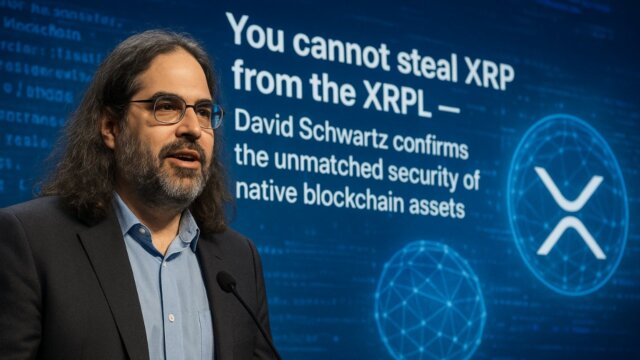- David Schwartz, CTO of Ripple Labs, asserts that XRP cannot be stolen from the XRP Ledger (XRPL), highlighting its unique security as a native blockchain asset.
- XRP exclusively resides on the XRPL, unlike bridged tokens, which still exist on their original chain.
- Compromising XRP necessitates compromising the XRPL itself, thereby enhancing its security compared to bridged assets.
In a recent revelation that cuts to the heart of blockchain security and native-asset integrity, David Schwartz, Chief Technology Officer of Ripple Labs and a co-architect of the XRP Ledger (XRPL), made a bold assertion: you cannot steal XRP from the XRPL. This seemingly simple statement carries profound implications for how we view native blockchain assets versus bridged tokens—and the risks they each carry. “You can’t steal XRP from XRPL because there is no place other than XRPL that XRP can be,” Schwartz tweeted, underscoring the fact that XRP is exclusively native to the XRPL and simply has no duplicate foothold on other chains.
Native vs. Bridged
Schwartz’s message draws a sharp line between two different classes of crypto assets: those native to a blockchain and those that are moved or “bridged” from one chain to another.
- For native assets like XRP, their origin chain is the only place where they exist. There is no parallel copy, no external “version” floating somewhere else. That means that if someone did try to “steal” them, they would have to compromise the very ledger that issues them—and that’s a far more difficult task.
- By contrast, when an asset is bridged—for example, if someone moves a token like ETH into the XRPL via a bridge—the original token still resides on its home chain (in this case, Ethereum). Schwartz points out that if the bridge is hacked, or the token stolen on the original chain, the native network (Ethereum, in this example) won’t intervene just because the token was moved. The token still legally exists on the origin chain even if its representation on the target chain is compromised.
This distinction is critically important for anyone thinking about security, asset ownership, and the architecture of blockchain ecosystems.
What Schwartz’s Point Really Means for XRP and XRPL
Let’s unpack what this means, both for XRP holders and for anyone looking to understand blockchain security at a deeper level.
- Full native integrity
When Schwartz says that XRP cannot be stolen from XRPL, he’s pointing to the fact that XRPL is the sole home of XRP. There is no alternative ledger that “also” contains XRP, so the only way to compromise XRP is to compromise XRPL itself. That gives XRPL a kind of security strength you don’t see in assets that are bridged across chains. - Network governance and fixability
Schwartz also points out that if a bug or technical problem arises with the asset itself, the XRPL community can act and fix it—because the asset is native and wholly managed within that network’s framework. He draws a parallel to the Bitcoin network in 2013, when Bitcoin experienced a network‐related incident and the community was able to repair it internally. - Reduced external dependency
Bridged assets bring in another layer of dependency—often on a third‐party bridge operator, multichain governance, or even two or more different chains. In those cases, even if the target chain is perfectly secure, the original chain or the bridge could be compromised. With XRP and XRPL, that extra layer simply doesn’t exist. - Misconceptions addressed
Some in the market wrongly assume that because an asset like XRP appears on multiple networks (via “wrapping” or proxy tokens), its security is the same as if it were native. Schwartz’s message is a clear counter to that: wrap the token, bridge it, whatever—you’re introducing additional risk layers.
Why Bridged Assets Carry Extra Risk
It’s not that bridged assets are inherently insecure—they serve important functions in cross-chain interoperability and liquidity flows. But the key takeaway is: they carry more moving parts, and more moving parts means more points of failure.
- Suppose you have ETH on Ethereum, and you bridge it to XRPL. That ETH still lives on Ethereum. If the bridge is hacked, or the relay mechanism fails, or the tokens are frozen or mismanaged on Ethereum, you may lose access or recourse.
- In such cases, no guarantee exists that the originating network (Ethereum) will step in because the token is still operational there—even if the bridged version is compromised.
- Schwartz explicitly states that even a network with strong governance can’t fully eliminate that risk when assets are moved across chains.
- This helps explain why cross‐chain transfers remain a prominent vector of hacks and exploits in the blockchain world.
Final Thoughts
In an era where crypto security is always under the microscope, Schwartz’s comment serves as a potent reminder: Not all tokens and chains are created equal when it comes to underlying asset integrity. By highlighting that XRP exists only on the XRPL—and therefore cannot simply be “stolen” because of a bridge flaw—he reaffirms the value of native architecture. For those navigating the crypto ecosystem—whether holders, developers, or institutions—this message is both a lens and a shield. It helps you evaluate where real risk lies, where you might be exposed, and which models deliver stronger security assurances.
Disclaimer: CryptopianNews shares this for learning and info only. It’s not meant to be financial or investment advice. Crypto markets change a lot and move quickly. Investing in them can be risky. You should always look into things yourself. Talk to a trained financial advisor before making any choices about investing.
- You Cannot Steal XRP from the XRPL: David Schwartz Explains - November 12, 2025
- Mark Moss on Bitcoin’s Next Evolution & What’s Coming - November 11, 2025
- Big Money Meets Blockchain: Wall Street Crypto Conundrum - November 9, 2025

